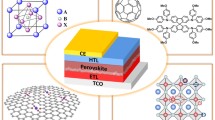Abstract
In this work, a numerical study has been carried out to investigate the impurity photovoltaic (IPV) effect for silicon solar cells doped with two impurities (indium and thallium). It is found that the conversion efficiency \(\eta \) of the IPV solar cell doped with two impurities can improve by 2.21 % absolute, which is greater than that of the IPV solar cell doped with indium (\(\Delta \eta =1.63\,\%\)), but less than that of the one doped with thallium (\(\Delta \eta =2.69\,\%\)). It is concluded that introducing two IPV impurities may not be a good selection for implementing the IPV effect since one impurity with poorer IPV effect can absorb some sub-bandgap photons while contributing fewer currents. The location of impurity energy level is critical to the IPV cell performance. For an acceptor-type IPV impurity, the optimized location of the IPV impurity energy level locates at 0.20–0.26 eV above the valence band edge. Our results may help to make better use of the IPV effect for improving solar cell efficiency.






Similar content being viewed by others
References
Agrawal, S., Tiwari, G.N.: Overall energy, exergy and carbon credit analysis by different type of hybrid photovoltaic thermal air collectors. Energy Conversat. Manag. 65, 628–636 (2013)
Azzouzi, G., Chegaar, M.: Impurity photovoltaic effect in silicon solar cell doped with sulphur: a numerical simulation. Phys. B 406, 1773–1777 (2011)
Burgelman, M., Decock, K., Khelifi, S., Abass, A.: Advanced electrical simulation of thin film solar cells. Thin Solid Films 535, 296–301 (2013)
Burgelman, M., Nollet, P., Degrave, S.: Modelling polycrystalline semiconductor solar cells. Thin Solid Films 361(362), 527–532 (2000)
Green, M.A.: Solar Cells: Operating Principles, Technology, and System Applications. Prentice Hall, New Jersey (1982)
Guha, S., Yang, J., Yan, B.: High efficiency multi-junction thin film silicon cells incorporating nanocrystalline silicon. Sol. Energy Mater. Sol. Cells 119, 1–11 (2013)
Hall, R.N.: Electron–hole recombination in germanium. Phys. Rev. 87, 387 (1952)
Holovsky, J., Bonnet-Eymard, M., Boccard, M., Despeisse, M., Ballif, C.: Variable light biasing method to measure component I–V characteristics of multi-junction solar cells. Sol. Energy Mater. Sol. Cells 103, 128–133 (2012)
Keevers, M.J., Green, M.A.: Efficiency improvements of silicon solar cells by the impurity photovoltaic effect. J. Appl. Phys. 75, 4022–4031 (1994)
Khelifi, S., Burgelman, M., Verschraegen, J., Belghachi, A.: Impurity photovoltaic effect in GaAs solar cell with two deep impurity levels. Sol. Energy Mater. Sol. Cells 92, 1559–1565 (2008a)
Khelifi, S., Verschraegen, J., Burgelman, M., Belghachi, A.: Numerical simulation of the impurity photovoltaic effect in silicon solar cells. Renew. Energy 33, 293–298 (2008b)
Luque, A., Marti, A.: Increasing the efficiency of ideal solar cells by photon induced transitions at intermediate levels. Phys. Rev. Lett. 78, 5014–5017 (1997)
Lucovsky, G.: On the photoionization of deep impurity centers in semiconductors. Solid State Commun. 3, 299–302 (1965)
Sahoo, H.S., Yadav, A.K., Ray, A.: Simulation of IPV effect in In-doped c-Si with optimized indium concentration and layer thickness. Physica B 406, 4221–4226 (2011)
Schmeits, M., Mani, A.A.: Impurity photovoltaic effect in c-Si solar cells: a numerical study. J. Appl. Phys. 85, 2207–2212 (1999)
Shockley, W., Read, W.T.: Statistics of the recombinations of holes and electrons. Phys. Rev. 87, 835–842 (1952)
Sze, S.M., Ng, K.K.: Physics of Semiconductor Devices, 3rd edn. Wiley, New York (2007)
Yuan, J., Shen, H., Zhong, F., Deng, X.: Impurity photovoltaic effect in silicon solar cells doped with tellurium. Optoelectron. Adv. Mater. Rapid Commun. 5, 866–869 (2011a)
Yuan, J., Shen, H., Huang, H., Deng, X.: Positive or negative gain: role of thermal capture cross sections in impurity photovoltaic effect. J. Appl. Phys. 110, 104508 (2011b)
Yuan, J., Shen, H., Zhong, F., Deng, X.: Impurity photovoltaic effect in magnesium-doped silicon solar cells with two energy levels. Phys. Status Solidi A 209, 1002–1006 (2012)
Zhang, Q., Su, J., Zhang, X., Li, J., Zhang, A., Gao, Y.: \(\text{ Bi }_{2}\text{ Se }_{3}/\text{ CdS/TiO }_{2}\) hybrid photoelectrode and its band-edge levels. J. Alloys Compd. 545, 105–110 (2012)
Zhao, B., Zhou, J., Chen, Y.: Numerical simulation of the impurity photovoltaic effect in silicon solar cells doped with thallium. Physica B 405, 3834–3837 (2010)
Acknowledgments
We acknowledge the free use of the SCAPS program developed by Prof. M. Burgelman’s group at the ELIS of the University of Gent, Belgium. We are very grateful to Prof. M. Burgelman for his helpful discussion about the IPV solar cell. This work was supported by the National Natural Science Foundation of China (Grant Nos. 61176062, 61306084, 51361022), the Priority Academic Program Development of Jiangsu Higher Education Institutions, the Ph.D. Programs Foundation of Ministry of Education of China (Grant No. 20113601120006), the Natural Science Foundation of Jiangxi Province of China (Grant No. 20122BAB202002) and the Science and Technology Project of Education Department of Jiangxi Province (Grant No. GJJ13010).
Author information
Authors and Affiliations
Corresponding author
Rights and permissions
About this article
Cite this article
Yuan, J., Shen, H., Zhou, L. et al. Impurity photovoltaic effect in silicon solar cells doped with two impurities. Opt Quant Electron 46, 1457–1465 (2014). https://doi.org/10.1007/s11082-013-9859-x
Received:
Accepted:
Published:
Issue Date:
DOI: https://doi.org/10.1007/s11082-013-9859-x




